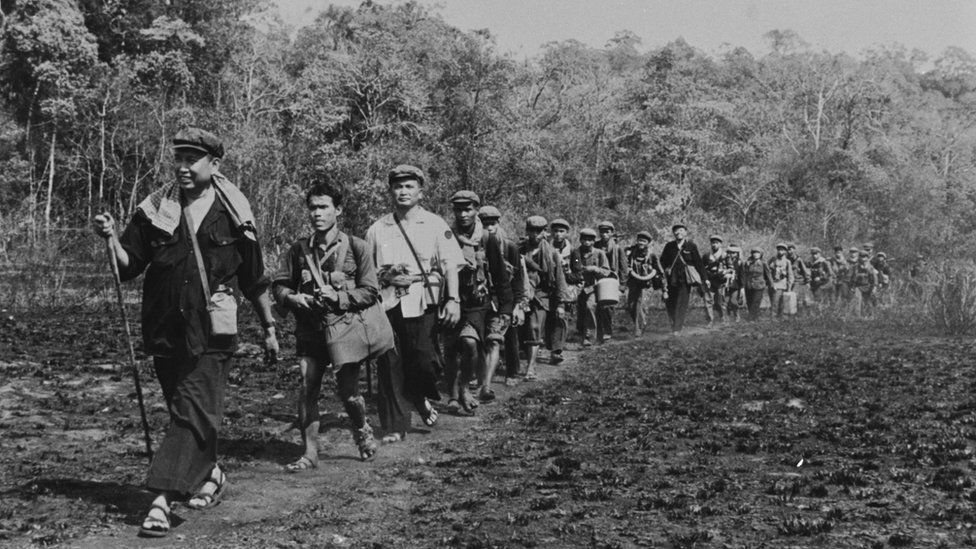The Khmer Rouge regime decimated more than a million Cambodians since the advent of its reign. Death by starvation, exposure, and execution was synonymous with this infamously brutal regime that lasted between 1975 and 1979.
The ‘enemies of the state’ faced the roughest of times before meeting their deaths. Those who were lucky enough to breathe their last fast enough escaped the horrors instigated using the crudest of weapons.
According to Prak Khan, ‘The instruments used for torturing were not ordered, in reality, whatever was there was used, like electric wires, pliers to remove nails, using needles to stick under the nails, in reality, we used whatever we had’ (Extraordinary Chambers in the Court of Cambodia 3).
Everyone who was suspected of or found to have been connected to the ousted Khmer Republic, an ally of the US, was subjected to the horrors that were carefully devised to punish the association. The college-educated, Buddhist monks, and specialists who worked in the former regime were the targets of the mass massacre.
Worse still, speaking against the new style of ruling, or asking for fairer treatment was a sure ticket to the torture or death chambers. According to a physician, ‘After we had written our autobiographies they called out die names of twenty young people who had been most outspoken in their criticism, tied their hands behind their backs the way you tie a parrot’s wings, and took them to Sisophon, where they were put in prison.’ (Fordham University)
When things went south, more terrors awaited the victims. It was especially so for the prisoners who tried to free themselves from the hangman’s noose that awaited them on the horizon. An attempt to break free was akin to a coup. It was met with undeserved force.
A schoolteacher’s confession gives a hint of the grave situation that every man, woman, and even child faced upon being sentenced to death for the simple suspicion of being a threat.
‘At the beginning of January 1976, . . . twenty of us were sentenced to death for traveling without permission. We were taken away in a truck with our hands tied behind our backs. One Khmer Rouge sat behind with a gun and two more sat in front with the driver. One of us managed to free himself and secretly untied eleven others. Then one of us tried to kill the Khmer Rouge sitting in the back of the truck, but the guards in front saw him and turned around and started shooting. The twelve who had their hands free jumped down from the truck and dived into the Mongkol Borei River by the side on the road, then disappeared into the forest. The other eight were killed on the spot,’ narrated the teacher (Fordham University).
The slightest provocation was enough to warrant death or imprisonment. An abnormal day would be one where there was no sign of arbitrary arrest or fusillading. For the simple mistake of going to look for food in the forest, one was almost sure to face either or both. At best, the Khmer Rouge’s methods of the ruling were inhumane and characteristic of scenes that can only be imagined to happen in traumatizing films.
In this nasty ordeal, the only lucky lot was that of the specialists who were taken to Preah Neth Preah. At least, they were given the chance to write their biographies and try to escape the high risk of facing execution after torture.
The crimes against humanity that were prompted by the anarchist regime in Cambodia beg the question of how well the US could have handled the situation.
The importance of Cambodia to the US during the Cold War was undisputable. It was for this reason that President Richard M. Nixon ordered the delivery of supplies in aid of the Khmer Republic. On December 9, 1970, the president talked to Henry A. Kissinger saying, ‘They have got to go in there and I mean really go in. I don’t want the gunships, I want the helicopter ships. I want everything that can fly to go in there and crack the hell out of them. There is no limitation on mileage and there is no limitation on budget. Is that clear?’(NS Archive 2).
However, Congress’s decision to desist from supporting the anti-communist forces in south-east Asia watered down this attitude towards Cambodia. The switch in policies changed the orientation of US-Cambodia relations.
The historians’ study of the US foreign relations has been less inclined towards the study of the US-Cambodia relations (Clymer 91). On the contrary, many studies are centered on Vietnam, yet the war largely involved Cambodia.
Of larger importance is the need to focus on the possibility of averting the genocide if the US-Cambodia relations had been differently oriented through more supportive policies. The available information on the events that took place in Cambodia after the withdrawal of support by the US provides a basis for research on the same, and actionable information that can be used in the future in case a similar situation arises. The effects of the Khmer Rouge’s actions are a wake-up call for the US policy-makers.







